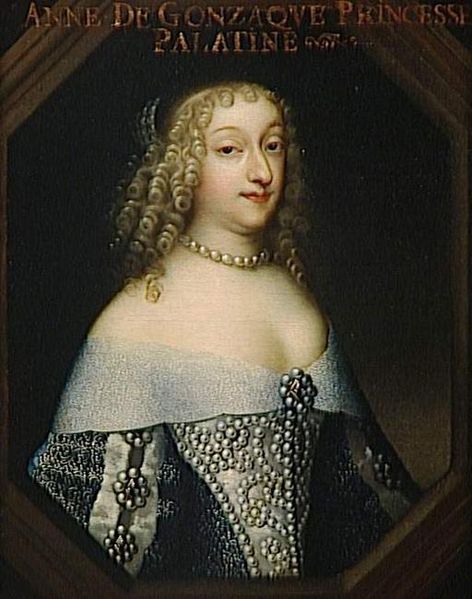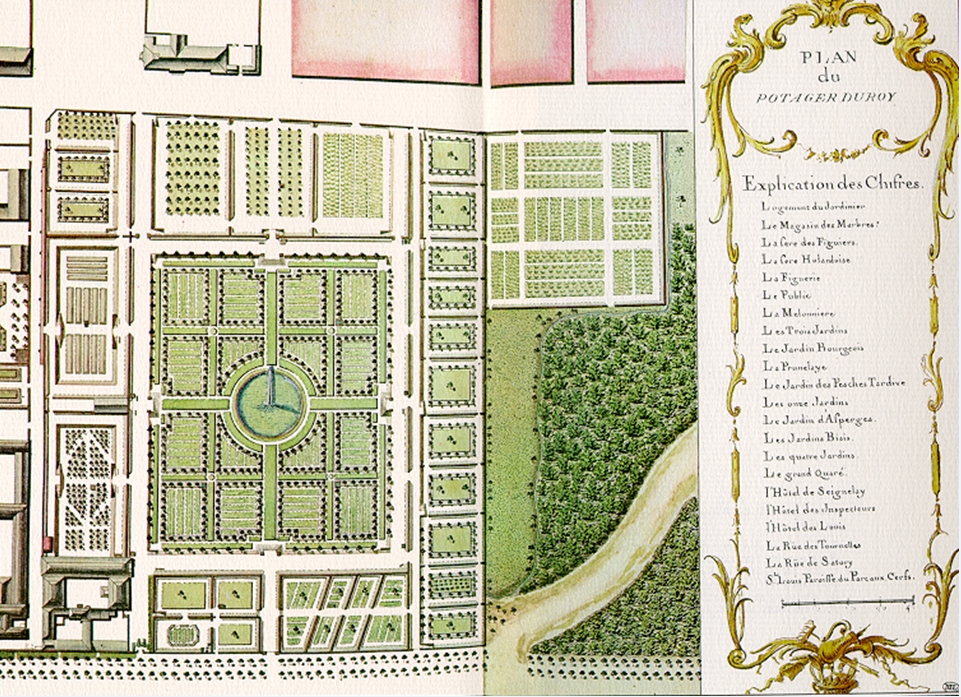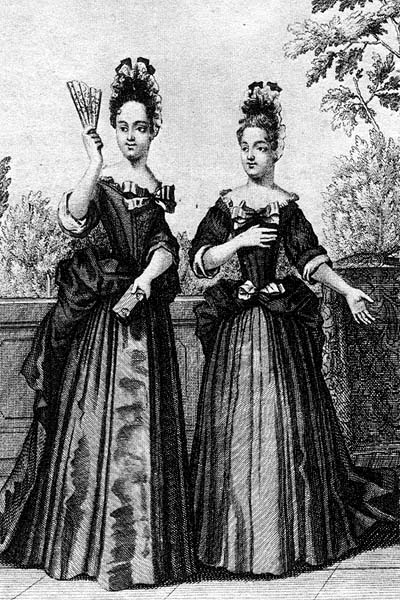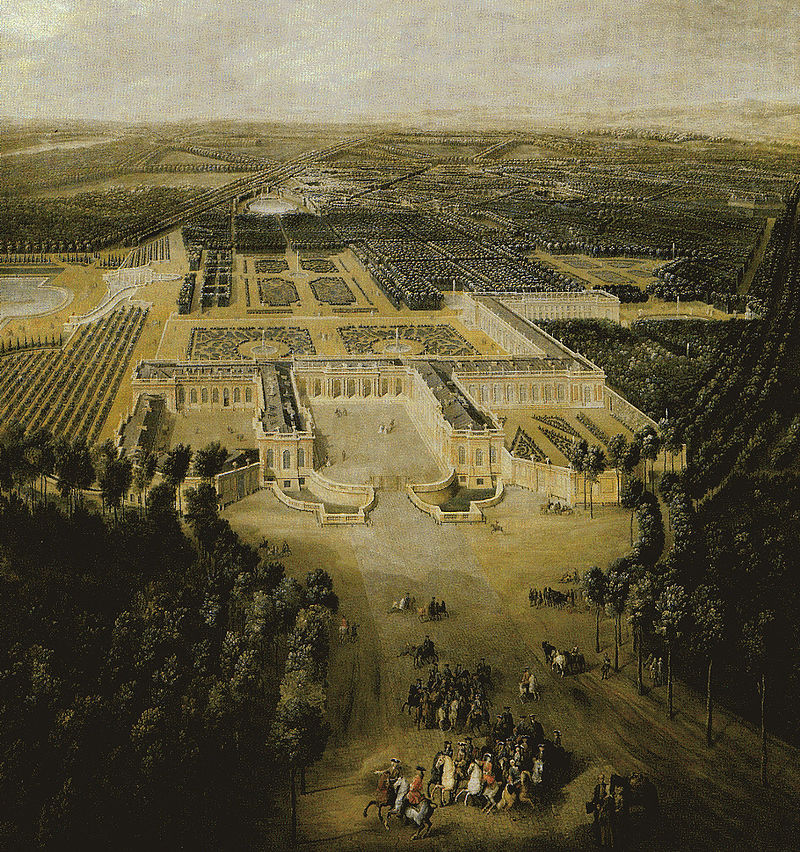Le Palais-Royal
The Palais-Royal in Paris, situated pretty much across the street from the Louvre, was home to many members of the royal family, including Louis XIV during the turbulent times of the Fronde. It was there, where he, still a child, had to face an angry Parisian mob in his bedroom.

Cardinal Richelieu bought the Hôtel de Rambouillet in 1624, which bordered on the old city-walls built by Charles V from 1356 to 1383, with the thought in mind that if this old wall would be demolished, the property could be extended quite a bit. Its location straight next to the Louvre, residence of the King, was a big plus too. Said old wall was taken down by 1633 and Louis XIII granted Richelieu the ownership of the land behind the Hôtel.
Already before Cardinal Richelieu was granted the ownership of the area behind the Hôtel, he made plans to use the space to have a Palais worthy of his person built. He hired the architect Jacques Lemercier for it. Construction commenced in 1633 and was completed in 1639. Monsieur Lemercier created an airy palace with sumptuous apartments and long galleries adorned by statues and paintings, called the Palais-Cardinal. Worthy of the most powerful man in France… but the Cardinal could only enjoy his palace for a couple of years. He died in 1642.
Upon the demise of Richelieu, the Palais-Cardinal became property of Louis XIII and as the latter died in 1643, it became property of the new King, Louis XIV. Since the Palais-Cardinal was much more comfortable than the old Louvre, with its thick walls and gloomy rooms, and also in possession of a pleasant garden, Anne d’Autriche, then Regent for Louis XIV, moved into the Palais with the Boy-King and his brother Philippe. The Palais-Cardinal was thus renamed Palais-Royal.
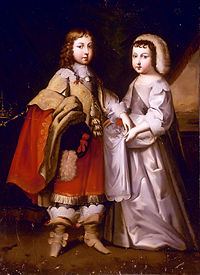
Cardinal Mazarin, responsible for the education of King and brother, had a miniature fort constructed in the garden of the Palais, which the royal brothers attacked and defended to playfully learn the art of war. Balls and feasts were held in honour of the King and courtiers strolled through the galleries… but then the Fronde happened.
Paris was suddenly no safe place for the King and his family anymore as raging mobs took over the city. Nobles got attacked on the streets and barricades went up. All the while, the little King and his family had to fear that a lynch-mob would knock at the doors of the Palais any time soon. Louis XIV could see the chaos on the streets from his windows in the Palais… they had to get out of there. As rumours spread of the King intending to leave the city and the mob gathered in front of the golden gates of the Palais, Anne d’Autriche saw no other chance to calm them than to let them into the royal residence and straight into the King’s bedroom. There, the young King was stretched out in bed, fully dressed in an outfit fit for travelling, under the duvet and pretended to be fast asleep. The mob tip-toed out again in order not to disturb the slumber of their monarch. As soon as they were gone, the royal family fled the Palais and Paris.
Louis XIV would never forget this experience and it tainted the Palais-Royal for him as well. Thus it is no surprise, that Louis did not claim the Palais for his own personal use, but left it to his brother. Philippe married his cousin Henrietta-Anne of England in 1661 and the Palais became their home. The bride was already quite familiar with it. The Palais-Royal was the home of Henrietta-Anne, nicknamed Minette, and her mother, Henriette-Marie de France, as the English Civil War forced the widowed Henriette-Marie to flee England with her children.
Philippe and Minette were wedded in the chapel of the Palais on 31 March in 1661. It was a small ceremony, but Philippe’s plans for his new home were far from small. He gave the Palais a proper revamp and had the crumbling walls and leaking roofs fixed. New apartments were installed for him and his wife, others renovated to be used by the couple’s favourites. The gardens were extended and replanted, making them the prettiest in all of Paris.
Since Philippe was rather fond of the theatre, the Théâtre du Palais-Royal was renovated as well. Facing the rue Saint-Honoré, the theatre was in the east wing of the Palais-Royal and was opened on 14 January in 1641 with a performance of Jean Desmarets’ tragicomedy Mirame. In the 1660’s the theatre troupe of Molière, under patronage of Philippe, settled there and celebrated success after success on the stage.
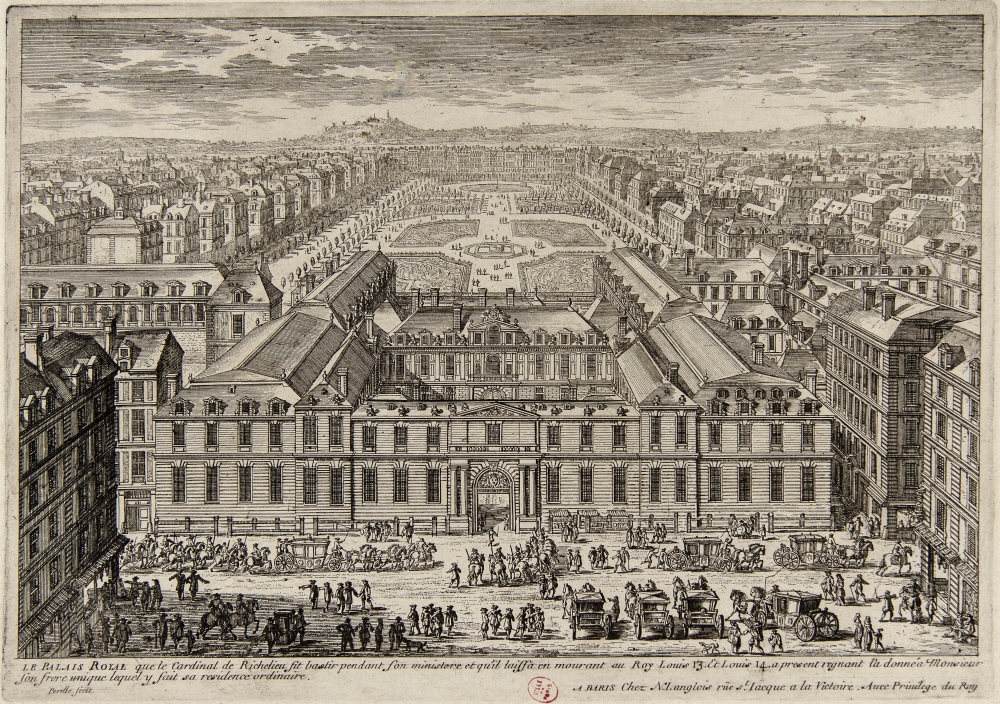
The Palais-Royal became the centre of the Parisian social life. Philippe and Minette entertained their guests regularly with balls, lotteries, promenades, banquets, fireworks and everything the spoiled courtier could dream of. Louis XIV visited his brother frequently to participate in the entertainments and to ogle the ladies. Many of his future mistresses came from the Household of Madame, aka the King’s hunting ground, and while some were only brief flirts, others, like Louise de La Vallière, Madame de Montespan and Angélique de Fontanges, left a lasting impression on the King.
After the death of Minette and Philippe’s second wedding, the Palais lost a bit of its importance in matters of social-life-hot-spot. The new Madame preferred Saint-Cloud to the Palais-Royal and although renovations and alterations improved the Palais further, she never got to love the Palais as much as Saint-Cloud… plus she was not exactly a person very fond of social gatherings.
That changed again in 1692, upon the marriage of Philippe’s son and heir, the Duc de Chartres, to Françoise-Marie de Bourbon, legitimised daughter of Louis XIV and Madame de Montespan. The marriage was a bit of a scandal, since a legitimised daughter was married to a proper Prince of France, and to soothe troubled hearts a little, the Palais-Royal changed ownership. Philippe and family had used the Palais as residence for a good thirty years already, before Louis XIV officially gifted it to his brother. Renovations were carried out again thus, the new Duchesse de Chartres needed a worthy apartment, and the Palais-Royal became once more the place to be. Especially since Versailles, that glorious golden palace outside Paris, had turned into a rather dull place after Madame de Maintenon rose to favour. Versailles was not was it used to be anymore, but thank God there was still the Palais-Royal with its balls and entertainments.
The Duc de Chartres became Duc d’Orléans after the death of Philippe in 1701 and in 1715, after the death of Louis XIV, he became Regent for the young Louis XV. The court left Versailles and settled in Paris, with the Palais-Royal being the centre of the government.
The Regent hired Gilles-Marie Oppenord to give the Palais another revamp and the place was turned into a fabulous Regency-style palace. The decor became lighter, the rooms brighter and a large apartment for the Regent was installed. Featuring a state bedchamber, a large dining room, a cabinet to receive ambassadors. For privacy, the Regent also had a smaller apartment built for himself.

Being a great fan of the arts, the Regent filled the Palais with a vast collection of paintings and all sorts of precious things, which curious visitors could behold when they pleased. The Regent was also a big fan of entertainments, thus there was hardly a day with no amusements being held at the Palais. In winter, on three days a week, masked balls were held and open to the public. Everyone could attend, if dressed properly and able to pay an entrance fee. The Regent loved to attend them as well and could often be found mingling in the large ballroom.
The Palais-Royal fell into slumber again with the death of the Regent in 1723. His son only had minor works done, most concerning the garden. It was still one of the prettiest places in all of Paris and open to the public, with the exception of servants in livrée and people in neglected garments. The garden attracted many visitors every day and since it was open to the general public, also people of a criminal nature. The Parisian police could not do much about it, because it was Orléans property, and thus prostitution flourished there.
The Palais also had its own opera, a hot-spot for the Parisian high society, until it burned down in 1763. The King had it rebuild, but also this new opera burned down.
The great-grandson of the Regent, known as Philippe-Égalité, was the next to execute major works at the Palais. Heavily indebted, he came up with the idea to rent the ground-floors of the buildings flanking the garden to traders. The Palais-Royal became the centre of commerce and pleasures, with 180 shops attracting locals and foreigners. The masked balls were still a la mode as well and where once the Regent mingled, rumour had it Marie-Antoinette could be spotted often now…
…until the Revolution. After the fall of the Monarchy, the Palais-Royal became the Palais-Égalité. Its owner Philippe-Egalité, who voted for the death of his cousin Louis XVI, renamed the property to make it appear less royal. He was arrested in his rooms at the Palais a year after the name change and his life ended like that of his cousin, with a guillotine rendezvous.
The Palais became property of the government afterwards. The furniture was sold, the rooms rented to whoever wanted. Many of the tenants took to altering the rooms, without great care, which in turn destroyed a lot of the original decor. Things did not improve under Napoleon. He installed the Tribunat at the Palais in 1800 and then the Parisian stock market moved in, occupying the ground floor of the central building.

Philippe-Egalité’s son, who became King of the French as Louis-Philippe, restored the Palais. It took eighteen years and a large sum of money to return the Palais to its former glory. New apartments were installed, a new gallery for paintings followed, pavilions were added and pretty much the moment the works were done, the Palais fell into another slumber for sixteen years. As King, Louis-Philippe had to leave the Palais for other residences. As he was overthrown, the Palais was looted and large parts of the new decor and furnishings destroyed. The Palais became property of the state again afterwards.
Napoléon III then decided to dedicate the Palais to the arts, but later on gave it to Jérôme Bonaparte, who lived there for eight years. In May 1871, the Commune de Paris, a radical socialist and revolutionary government that ruled Paris from 28 March to 28 May 1871, thought it a great idea to set the Palais on fire. Three fires were lit within the Palais, but luckily the fire could be brought under control by some of the neighbours with the help of workers of the Banque de France and the damage was not too big. (The Commune de Paris also set fire to Tuileries, the Imperial Library at the Louvre, the Palais de Justice, the Palais d’Orsay, the Hôtel de Ville and the Palais de la Légion d’honneur among others.)
Today the Palais-Royal houses the Conseil d’État, the Constitutional Council, the Ministry of Culture and the Comédie-Française. It’s garden is still open to the public and one of the prettiest of all of Paris.
